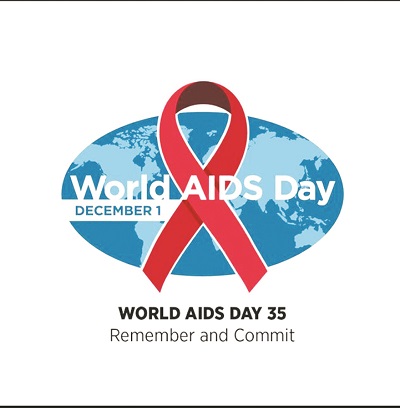By: T’soloane Mohlomi
National Aids Commission Lesotho (NAC) has officially launched activities leading up to the commemoration of World Aids day, which is celebrated annually on the first of December.
With the commemoration of the day marking the global pandemic’s awareness and honouring people living with and affected by the virus around the World, the day was first celebrated in 1988 and this year marks its 35th anniversary.
Due to the milestone in the fight against the virus, the theme for this year is World AIDS Day 35 Let Communities lead.
Speaking at the launch hosted at the National Aids Commission Lesotho premises in Maseru, NAC Lesotho Chief Executive Officer (CEO) Ms Lebohang Mothae said she appreciated the presence of Civil Society Organizations (CSO’s) and Youth Organizations as the Basotho community played a vital role in the fight against HIV/AIDS over the years.
She said it was pivotal for the nation to present a united front, which depicted synergy and cohesion if it were to be possible to reach the goal of an AIDS free Lesotho in the year 2030.
“In accordance with the UN’s sustainable development goals which Lesotho also aligns with it is very important to stand together, united with different sectors of the community and our various stakeholders whether local or international to ensure we meet the envisaged target of an AIDS free Lesotho in 2030.
“The sight of youth representation in this meeting really pleases me because they are the future of this country and they need proper briefing on issues which continue to affect them. Youth should also be offered a platform to contribute in these important matters as their voice matters.
“Civil society organisations can also never be left behind because the communities in Lesotho have always been involved in the fight against HIV/AIDS,” She said.
Also speaking at the event UNAIDS (United Nations AIDS) Country Director Lesotho Ms Pepakai Chikukwa, said the UNAIDS July report indicated that 2.5 million infections were recorded per year during the covid-19 pandemic, however indicated that Lesotho has since been making strides in the fight against the virus with a 74% reduction recorded since the year 2020 in Lesotho.
She said a recorded number of 3.4 million mother to child avoided infection were recorded but the challenge remained as every week a large percentage of adolescent girls and young women were infected with HIV, saying the biggest infectors appeared to be sex workers and men having sex with other men.
“In its Global AIDS Update ‘The Path That Ends AIDS’ published in July this year, UNAIDS noted that there has been significant progress in the Global HIV response. Two decades ago, the global AIDS pandemic seemed unstoppable, with more than 2.5 million people getting infected with HIV, and AIDS claiming two million lives each year.
“Fast forward to 2022, an estimated 1.3 million people infected, the fewest in decades. Declines were especially strong in regions with the highest HIV burdens like sub-Saharan Africa, where in Lesotho the decline since 2010 was 74%, placing the country 3rd globally.
“Vertical transmission programmes averted 3.4 million new HIV infections in children since 2000. 650 000 people died of AIDS related-illnesses last year, reduced by 69% since the peak in 2004. Several countries however have made significant progress in their treatment programmes. Botswana, Eswatini, Rwanda, the United Republic of Tanzania and Zimbabwe, have achieved the 95–95–95 targets, and at least 16 other countries (including in Lesotho) are close to doing so.
“However, barriers, including a widening funding gap, hold back faster progress. Young women in Africa remain disproportionately affected by HIV, where every week, 4000 adolescent girls and young women get infected with HIV in sub-Saharan Africa. Coverage of dedicated programmes for them remains too low, with only about 42% of districts with very high HIV incidence in sub-Saharan Africa currently covered with dedicated prevention programmes for adolescent girls and young women. Only a third of people in key populations— including gay men and other men who have sex with men, transgender people, people who use drugs, sex workers, and prisoners—have regular prevention access.” She said.
“Key populations face major barriers including criminalisation, discrimination, and stigma. Millions still miss out on treatment. In 2022, close to 9.2 million people living with HIV were not receiving HIV treatment. Treatment coverage lags for children (aged 0–14 years), adolescents and men. The funding gap is widening…. A total of US$ 20.8 billion was available for HIV programmes in low- and middle-income countries in 2022 well short of.”
Representing the legislature and communities, Principal Chief of Thaba-Bosiu; Chief Khoabane Theko weighed in on the matter saying that the journey was long but the narrative had now changed in Lesotho as people were now more informed than they used to be in the past.
Making an example of when he met an infected person way back on an excursion in Cape Town, Chief Theko narrated a story of how scared he was upon meeting the individual. He said like most people then he didn’t have a good understanding of the virus and as a result that created a stigma around the disease which was terrifying to the nation in general.
“Things have changed now in Lesotho, what others perceive as a disease which only infected certain people has now also killed prominent people as well. This led to people taking AIDS seriously and seeing that indeed it does not discriminate.
“I am proud because now the nation has a better understanding and tolerance of the virus and we are now an example to other countries who came to learn from us how we are able to manage the virus. I urge the complete killing of the stigma because despite our strides thus far it is evident that it still exits,” he said.


